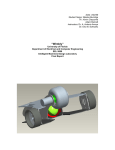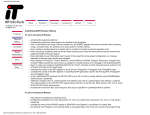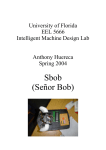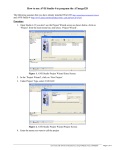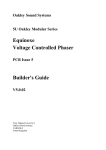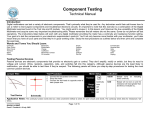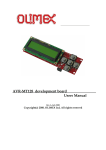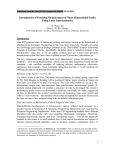Download Automatic Temperature Control System
Transcript
Automatic Temperature Control System San Jose State University Department of Mechanical and Aerospace Engineering ME106 – Fundamentals of Mechatronics Professor: Burford Furman, Ph.D Submitted By Garry Jackson and Jason Jocson May 16, 2006 1 Table of Contents Table of Contents...................................................................................................................................... 2 Summary ................................................................................................................................................... 3 Introduction............................................................................................................................................... 4 Schematics ................................................................................................................................................ 5 Circuit Diagram ........................................................................................................................................ 6 BlockDiagram ........................................................................................................................................... 7 Description................................................................................................................................................ 8 Methodology ............................................................................................................................................. 8 Problems Encountered ............................................................................................................................ 10 Building tips:......................................................................................................................... 10 Conclusion .............................................................................................................................................. 11 References............................................................................................................................................... 13 Appendix................................................................................................................................................. 14 Software Program ................................................................................................................. 14 2 Summary In the spring 2006 Mechatronics class at San Jose State University, our group designed a project that implemented what we learned over the course of the semester. It became our goal to materialize a system that employed a microcontroller, sensors and actuators. In the photograph below, the microcontroller device on the bottom is connected to a breadboard circuit that controls the fan speed, depending on the status of the motion detector and temperature sensor. To implement this project, we segmented the project into terms of software and hardware. First, we devised a schematic diagram that would control a fan to operate at 3 different speeds. The speed would be controlled by the microcontroller by sending out a +5V 3 signal through a network of transistors which would result at turning on a fan at a particular speed. By the end of the project, our group had implemented many topics that we learned throughout the semester. By using transistor theory, circuit analysis, and software programming, we were able to implement a microcontroller based automatic temperature control system. Introduction The purpose of this project is to demonstrate how microcontrollers can be used and applied in a real-world application. One practical use is to incorporate a microcontroller in a temperature control system that can be used for automatically controlling a rooms’ temperature. By using a system of sensors and actuators, a microcontroller can act as an active device that responds to various inputs by sending control signals to other branches of a circuit that controls their corresponding actuators. The microcontroller our group decided to use was an Atmega-128 based microcontroller that was programmed with an Olimex AVR-MT128. Similar to the STK500 board, this unit is programmable via JTAG ports behind the unit connect to a PC via a USB cable. The MT-128 is Equipped with an LCD display, capable of outputting status messages, character strings or any other information a user wishes to display. In addition to the LCD, the MT-128 has other usable features such as 6 pushbutton switches, a relay and buzzer. As the main component of the project, this unit controlled an external circuit that would function as a temperature controller, utilizing a motion detector sensor, a temperature sensor, and a motorized fan. 4 Schematics 5 Circuit Diagram +5V' R4 22K V0 DB4 DB5 DB6 DB7 RS R/W E 35 36 37 38 39 40 41 42 3 11 12 13 14 4 5 6 LCD VCC_BAR R1 RESISTOR 61 60 59 58 57 56 55 54 64 62 63 D1 LM335/TO92 XTAL1 XTAL2 PA0/AD0 PA1/AD1 PA2/AD2 PA3/AD3 PA4/AD4 PA5/AD5 PA6/AD6 PA7/AD7 TOSC1/PG4 TOSC2/PG3 PC0/A8 PC1/A9 PC2/A10 PC3/A11 PC4/A12 PC5/A14 PC6/A14 PC7/A15 ADC0/PF0 ADC1/PF1 ADC2/PF2 ADC3/PF3 ADC4/TCK/PF4 ADC5/TMS/PF5 ADC6/TD0/PF6 ADC7/TD1/PF7 PB7/OC2/OC1C PB6/OC1B PB5/OC1A PB4/OC0 PB3/MIS0 PB2/MDSI PB1/SCK PB0/SS 51 50 49 48 47 46 45 44 B5 VCC_BAR 1 VDD 2 U4 RESET/ 17 16 15 14 13 12 11 10 MG1 D2 DIODE 2 R9 19 18 R8 22K VCC VCC 24 23 +5V R7 22K B4 MOTOR AC R2 60ohm Q1 2N3904 AVCC R3 90ohm Q2 2N3904 AVREF Q3 2N3904 GND GND 20 B3 AGND 22 53 POT B2 R6 22K 52 21 B1 U2 R5 22K MEGA128.8MM U3 1 OUT +Vcc GND Motion Sensor 6 3 2 BlockDiagram Garry Jackson and Jason Jocson 3/23/2006 Fan Control Block Diagram Motion Sensor Possible chips include Not found yet The fan control allow the user to set the fan to change speeds automatically depending on if there is motion in the room and the temperature difference that is in the room. Temperature Sensor Possible chips include DS18S20 3pins AVR MEGA 128 Microcontroller Motor This will run at 3 speeds and two directions which will be controlled using the microcontroller, h bridge and varying the duty cycle. There will be an set of switches that will allow the user to say which speed they want the fan if different then the automatic settings. Optional: An LCD that will output the temperature of the room, what speed the fan is going and which direction. Also if the motion sensor is tripped or not. Temperature Difference 2 4 6 Motion Sensor Active Active Active 4 Deactive 8 Deactive 12 Deactive 7 Fan Speed 1 2 3 1 2 3 Description The initial function of this project is to simulate an automatic temperature control system that could be used in closed areas where ambient temperatures fluctuate. However, in order to save electricity, a motion sensor that is integrated into the circuit is used to activate a variable-speed fan which operates either at the users desired setting, or an automated setting that is dependent on the temperature difference of the room’s measured temperature and an internally set temperature determined by the user. In the user manual mode, a motion sensor enables the circuit to be set at a specific fan speed to cool the room. As long as there is a presence that the motion detector senses, the fan will continue cool the room at its set speed. If the user leaves the room with the fan on, the motion detector will disable the fan and turn it off to save electricity. In the automatic mode, a motion sensor will enable the circuit to actuate a fan to cool the room automatically. If the temperature difference in the room is 1-5 degrees from its set point, the fan will automatically spin at 1/3 of its speed. If the temperature difference is between 6 -10 degrees from its set point, the fan will spin at 2/3s of its speed. If the temperature difference is greater than 10 degrees from the set temperature, the microcontroller will set the fan to its full speed to cool the room the fastest. Methodology When taking on a new electronics project, it is important to carefully organize the methods in which the project must be performed. Because there can be various systems and subsystems to deal with, it is best to break the systems down into smaller, manageable tasks to complete. In putting together our project, we chose to approach it by segmenting it in terms of hardware procedure and software procedure. 8 When building the temperature control system, I prepared a workspace that could accommodate the tools, equipment, and materials that were required for the project. By clearing a large area on my desk, I placed soft absorbing cloth across the workspace so that any loose materials will not easily roll of the desktop in the event of any parts or pieces becoming loose to bounce and roll off the desk. The soft material can absorb any stray moving components and catch it before it gets lost. This prepared me to take the necessary steps in getting ready for the assembly of the project. Our main source of instruction in building the circuit was to follow the schematic we generated by using MultiSim. After populating the breadboard with the 2N3904 transistors, and resistors, we applied +5 voltage through the circuit to simulate the controller sending the voltage coming from the mictrontroller. We were able to get 3 different voltage outputs to the fan, which would represent a fan speed at each stage. The transistors would act as an electronic switch that, when triggered, it would open the 12V supply to the fan. At each stage, we inserted resistors on 2 of the 3 stages to reduce the voltage going to the fan. This would result in a Lo, Med, and Hi setting. The temperature sensor and the motion sensor both operate on +5V and have one output pin. The Vcc and Ground pins were then connected directly on the breadboard and the output pin was tied to the microcontrollers input. The Motion sensor was tied to the one of the port pins while the temperature controller was connected to the ADC. This would allow for the controller to use a closed feedback system where the temperature sensor would feed a voltage into the ADC and the microcontroller would compare it to a setpoint temperature fixed inside the microcontroller. The microcontroller would then take the comparison and determine what speed the fan should go to by checking against an index of temperature differences. If the measured temperature was within 2 degrees of the setpoint, it would trigger the Lo setting of the fan. If the measured temperature was within 3-5 degrees of the set temperature, it would trigger the Medium setting of the fan circuit, and any temperature 6 degrees or greater it would trigger the maximum output (12V) to the fan. 9 Problems Encountered Building tips: 1. No power – ac voltage is not reaching the circuit. By measuring the voltage across various resistors, pin ports and IC leads, we were able to troubleshoot and determine the culprit of not having any power to our circuit 2. Bad soldering – soldering leads onto our sensors and fans may have bad solder joints an can cause a bad connection for power continuity throughout the circuit 3. Wires go the wrong places – sometimes leads would be placed into the wrong row of a breadboard and would cause a misconnection or open circuit 4. Wrong part or parts put in the wrong places – the resistors we used may have been mistaken for a wrong value. Sometimes if we need a 1K resistor, we got mistaken by reading the color codes as a 10K 5. Polarized parts put in the wrong, way - Transistor pin-out varies, so check the pin-out of the devices you get. Electrolytic caps often look like a short if the voltage is reversed. 6. Bad parts – even when we confirmed that our circuit was wired up correctly, we were able to narrow our problem down to a bad part. A defective motion sensor will not allow the rest of the circuit. After we replaced it, it worked fine.: In the website http://www.geofex.com/Article_Folders/howto.pdf, the author discusses several tips for troubleshooting electronic circuits: • For NPN transistors used as amplifiers, with no signal, the collector is the most positive voltage, usually by at least a couple of volts; the base is somewhat lower and the emitter is invariably 0.5 to 0.7V (0.2 to 0.3 in germanium) lower than the base. If this is not true, something is fouled up about the biasing on that stage. • For PNP transistors used as amplifiers, with no signal, the collector is the most negative voltage, usually by at least a couple of volts; the base is somewhat higher and the emitter is 10 invariably 0.5 to 0.7V (0.2 to 0.3 in germanium) higher than the base. If this is not true, something is fouled up about the biasing on that stage. • For bipolar (NPN/PNP) transistors, if the collector/base, collector emitter or base/emitter are exactly the same voltage, either there is a circuit board short or the device is internally shorted and dead. • To check a bipolar transistor, read the collector voltage; short the base to the emitter with a clip lead. The collector voltage should go up except for cases where the collector is tied to the + power supply. In that case, the emitter will go down significantly. • Measure the power voltages of IC's directly at the pins of the IC • Op-amps used as linear amplifiers must have the negative input and the positive input at the same voltage +/- a few millivolts of the positive input. If this is not true, the op-amp is dead or the circuit board is fouled up some way (not true if it's used as a comparator!) • Op-amp positive and negative inputs and output pins should usually all be between +2 and +7 volts DC with respect to ground in single battery systems for linear amplifier op-amps, not including some special “rail-to-rail” op-amps, comparator use and some precision rectifiers. Conclusion Upon the completion of our project, we were happy that it was able to function correctly. The circuit design and software debugging were the most difficult to implement, but once it started to work, the trouble became worthwhile and was very rewarding for our group. If we had more time to complete the project, we could make a display that would look more practical, rather than just have some electronic breadboard populated with transistors, resistors and capacitors. Instead, we can cover the circuit and make a display of a model bedroom that had an overhead fan with the temperature sensor in the corner of the room. It was an idea to use an 1157 11 automotive bulb to place near the temperature sensor that would simulate heat from the sun to trigger the the fan to an appropriate speed. Ultimately, we were satisfied that our project was able to function properly and do what it was designed to do. 12 References http://www.geofex.com/Article_Folders/howto.pdf http://home.iae.nl/users/pouweha/lcd/lcd0.shtml#pin_assignment http://www.olimex.com/dev/images/avr-mt128-sch.gif 13 Appendix Software Program /***************************************************** This program was produced by the CodeWizardAVR V1.24.6 Professional Automatic Program Generator © Copyright 1998-2005 Pavel Haiduc, HP InfoTech s.r.l. http://www.hpinfotech.com e-mail:[email protected] Project : ME 106 - Fan Controller Version : 1.0 Date : 5/10/2006 Author : Garry Jackson and Jason Jocson Company : Comments: Reads if there is motion in a room and what the temperature is and determines the speed of the fan. Output if there is motion, the temperature, and the fan speed to the LCD display. Chip type : ATmega128 Program type : Application Clock frequency : 8.000000 MHz Memory model : Small External SRAM size : 0 Data Stack size : 1024 *****************************************************/ #include <mega128.h> #include <delay.h> #include <stdio.h> // Alphanumeric LCD Module functions #asm .equ __lcd_port=0x15 ;PORTC #endasm #include <lcd.h> // External Interrupt 0 service routine interrupt [EXT_INT0] void ext_int0_isr(void) { // Place your code here } #define ADC_VREF_TYPE 0x00 // Read the AD conversion result unsigned int read_adc(unsigned char adc_input) { ADMUX=adc_input|ADC_VREF_TYPE; // Start the AD conversion ADCSRA|=0x40; // Wait for the AD conversion to complete while ((ADCSRA & 0x10)==0); ADCSRA|=0x10; return ADCW; } // Declare your global variables here #define #define #define #define #define #define #define #define #define MOTION_SENSOR FAN_SPEED1 FAN_SPEED2 FAN_SPEED3 B1 B2 B3 B4 B5 PORTB.3 PORTB.4 PORTB.5 PORTB.6 PINA.0 PINA.1 PINA.2 PINA.3 PINA.4 const unsigned char Intro[] = " Fan Controller Version: 1.0 "; char lcd_buffer[33]; // Buffer for storing output for the LCD display unsigned char motionint; // Motion sensor checking loop number unsigned char motionrun; // Motion sensor high returns per loop unsigned char motion_laststate; // Last motion sensor state unsigned char motion_state; // Current montion sensor state unsigned char motion_state_number; // Number of runs in current state reading unsigned char motion_display; // Display text for if the display on or off unsigned char temperature; // Temperature ADC reading unsigned char temp_c; // Temperature in c unsigned char temp_desire=30; // Desired Temperature unsigned char temp_c_diff; // Temperature Difference unsigned char fan_speed; // Fan Speed unsigned char button_loop; // Loop number for button reading unsigned char control_auto; unsigned char control_state; // Control State is used for auto mode or manual fan speed // Fan Speed Temperature Difference unsigned char m_active_s1=2; // set the temperature variation 15 unsigned char m_active_s2=4; unsigned char m_inactive_s1=4; unsigned char m_inactive_s2=8; // set the temperature variation // set the temperature variation // set the temperature variation void main(void) { // Declare your local variables here // Input/Output Ports initialization // Port A initialization // Func0=In Func1=In Func2=In Func3=In Func4=In Func5=In Func6=Out Func7=In // State0=T State1=T State2=T State3=T State4=T State5=T State6=0 State7=T PORTA=0x00; DDRA=0x40; // Port B initialization // Func7=Out Func6=Out Func5=Out Func4=Out Func3=In Func2=In Func1=In Func0=In // State7=0 State6=0 State5=0 State4=0 State3=T State2=T State1=T State0=T PORTB=0x00; DDRB=0xF0; // Port C initialization // Func7=In Func6=In Func5=In Func4=In Func3=In Func2=In Func1=In Func0=In // State7=T State6=T State5=T State4=T State3=T State2=T State1=T State0=T PORTC=0x00; DDRC=0x00; // Port D initialization // Func7=In Func6=In Func5=In Func4=In Func3=In Func2=In Func1=In Func0=In // State7=T State6=T State5=T State4=T State3=T State2=T State1=T State0=T PORTD=0x00; DDRD=0x00; // Port E initialization // Func7=In Func6=In Func5=In Func4=In Func3=In Func2=In Func1=In Func0=In // State7=T State6=T State5=T State4=T State3=T State2=T State1=T State0=T PORTE=0x00; DDRE=0x00; // Port F initialization // Func7=In Func6=In Func5=In Func4=In Func3=In Func2=In Func1=In Func0=In // State7=T State6=T State5=T State4=T State3=T State2=T State1=T State0=T PORTF=0x00; DDRF=0x00; // Port G initialization // Func4=In Func3=In Func2=In Func1=In Func0=In // State4=T State3=T State2=T State1=T State0=T 16 PORTG=0x00; DDRG=0x00; // Timer/Counter 0 initialization // Clock source: System Clock // Clock value: Timer 0 Stopped // Mode: Normal top=FFh // OC0 output: Disconnected ASSR=0x00; TCCR0=0x00; TCNT0=0x00; OCR0=0x00; // Timer/Counter 1 initialization // Clock source: System Clock // Clock value: Timer 1 Stopped // Mode: Normal top=FFFFh // OC1A output: Discon. // OC1B output: Discon. // OC1C output: Discon. // Noise Canceler: Off // Input Capture on Falling Edge // Timer 1 Overflow Interrupt: Off // Input Capture Interrupt: Off // Compare A Match Interrupt: Off // Compare B Match Interrupt: Off // Compare C Match Interrupt: Off TCCR1A=0x00; TCCR1B=0x00; TCNT1H=0x00; TCNT1L=0x00; ICR1H=0x00; ICR1L=0x00; OCR1AH=0x00; OCR1AL=0x00; OCR1BH=0x00; OCR1BL=0x00; OCR1CH=0x00; OCR1CL=0x00; // Timer/Counter 2 initialization // Clock source: System Clock // Clock value: Timer 2 Stopped // Mode: Normal top=FFh // OC2 output: Disconnected TCCR2=0x00; TCNT2=0x00; OCR2=0x00; 17 // Timer/Counter 3 initialization // Clock source: System Clock // Clock value: Timer 3 Stopped // Mode: Normal top=FFFFh // Noise Canceler: Off // Input Capture on Falling Edge // OC3A output: Discon. // OC3B output: Discon. // OC3C output: Discon. // Timer 3 Overflow Interrupt: Off // Input Capture Interrupt: Off // Compare A Match Interrupt: Off // Compare B Match Interrupt: Off // Compare C Match Interrupt: Off TCCR3A=0x00; TCCR3B=0x00; TCNT3H=0x00; TCNT3L=0x00; ICR3H=0x00; ICR3L=0x00; OCR3AH=0x00; OCR3AL=0x00; OCR3BH=0x00; OCR3BL=0x00; OCR3CH=0x00; OCR3CL=0x00; // External Interrupt(s) initialization // INT0: On // INT0 Mode: Rising Edge // INT1: Off // INT2: Off // INT3: Off // INT4: Off // INT5: Off // INT6: Off // INT7: Off EICRA=0x03; EICRB=0x00; EIMSK=0x01; EIFR=0x01; // Timer(s)/Counter(s) Interrupt(s) initialization TIMSK=0x00; ETIMSK=0x00; // Analog Comparator initialization // Analog Comparator: Off // Analog Comparator Input Capture by Timer/Counter 1: Off 18 ACSR=0x80; SFIOR=0x00; // ADC initialization // ADC Clock frequency: 125.000 kHz // ADC Voltage Reference: AREF pin ADMUX=ADC_VREF_TYPE; ADCSRA=0x86; // LCD module initialization lcd_init(16); // Global enable interrupts #asm("sei") lcd_gotoxy(0,0); lcd_putsf(Intro); delay_ms(5000); // goto the top left corner // write intro message to display // pause 5seconds while (1) { temperature=read_adc(0); temp_c=temperature+14; // Read the ADC value for the temperature sensor // Convert the ADC temperature value to c temp_c_diff=temp_c-temp_desire; // Find the difference between measure and desired temperature if(control_auto=="YES") { motionint=0; motionrun=0; while (motionint<4) { if(PINB.3==1) { motionrun++; } motionint++; delay_ms(250); } // If control=yes then check motion sensor and select fan speed // clear motionint counter for while loop that checks for motion // clear motionrun counter for while loop that checks for motion // run this loop until motionint=4 and exit // check if there is signal on pinb.3 which is the motion sensor // if the motion sensor is active increment motionrun // increment motionint for next while loop // wait .25 seconds before the next check if (motionrun>0) // if the motion sensor went hi during one of the 4 checks set motion_state=active motion_state="active"; if (motionrun==0) // if motionrun=0 set it to inactive showing that the sensor did not pick up movement motion_state="inactive"; 19 // if the current state is not equal to the last state this function will increment motion_state_number // this if/else is designed for the circuit doesn't go between active inactive over and over because of // false reasing or someone keeps coming in and out of the room very frequently. if (motion_laststate!=motion_state) { motion_state_number++; } else if (motion_laststate!=motion_state && motion_state_number==1) { motion_laststate=motion_state; motion_state_number=0; } //This set of if/else look at the desired temp and the temp being read to decide what speed the fan should be. if (motion_laststate=="active" && temp_c_diff<=m_active_s1) // Fan Speed temperature varience if motion sensor is active fan_speed=3; else if (motion_laststate=="active" && temp_c_diff<=m_active_s2) // Fan Speed temperature varience if motion sensor is active fan_speed=2; else if (motion_laststate=="active" && temp_c_diff>m_active_s2) // Fan Speed temperature varience if motion sensor is active fan_speed=3; if (motion_laststate=="inactive" && temp_c_diff<=m_inactive_s1) // Fan Speed temperature varience if motion sensor is active fan_speed=1; else if (motion_laststate=="inactive" && temp_c_diff<=m_inactive_s2) // Fan Speed temperature varience if motion sensor is active fan_speed=2; else if (motion_laststate=="inactive" && temp_c_diff>m_inactive_s2) // Fan Speed temperature varience if motion sensor is active fan_speed=3; } if(fan_speed==1) { FAN_SPEED1=1; //turn the low speed on FAN_SPEED2=0; //turn the medium speed off FAN_SPEED3=0; //turn the high speed off } 20 if(fan_speed==2) { FAN_SPEED1=0; FAN_SPEED2=1; FAN_SPEED3=0; } if(fan_speed==3) { FAN_SPEED1=0; FAN_SPEED2=0; FAN_SPEED3=1; } //turn the low speed off //turn the medium speed on //turn the high speed off //turn the low speed off //turn the medium speed off //turn the high speed on if(motion_laststate=="active") // check state of motion_laststate and set motion_display=1 if active // this shows a 1 or 0 on the display depending on which one is set. motion_display=1; else motion_display=0; //load the top line into the lcd_buffer for lcd_puts. sprintf replace the %#u with the number in the //variable temp_c and fan_speed sprintf(lcd_buffer,"Temp:%3u Speed:%1u",temp_c,fan_speed); lcd_clear(); //clear the display lcd_gotoxy(0,0); //move to the top left lcd_puts(lcd_buffer); //write the buffer to the lcd display sprintf(lcd_buffer,"MontionSensor:%u",motion_display); lcd_gotoxy(0,1); lcd_puts(lcd_buffer); button_loop=0; while (button_loop<200) // button loops runs every 50ms for 200 times and the main loop starts again { if (B1==0) //if b1 or top button pressed go into auto mode control_auto="YES"; control_state=1; if (B2==0) //if b2 or left button pressed turn fan to speed 1 and auto off { control_auto="NO"; fan_speed=1; control_state=0; } if (B3==0) //if b3 or middle button pressed turn fan to speed 1 and auto off { control_auto="NO"; fan_speed=2; control_state=0; } 21 if (B4==0) { //if b4 or right button pressed turn fan to speed 1 and auto off control_auto="NO"; fan_speed=3; control_state=0; } delay_ms(50); button_loop++; // wait 50ms before next loop start // increment button_loop for next loop number. } }; } 22























